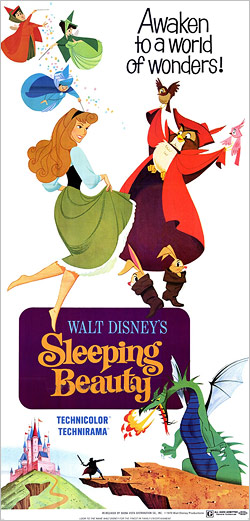 |
Site created 12/15/97.

page created: 12/15/08
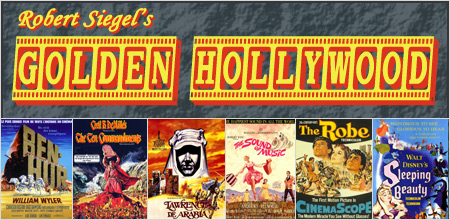 Robert Siegel - Main Page NOTE: The scans below are the property of Robert Siegel and The Digital Bits, and may not be reposted without permission. Copyright of the images belongs to the respective studios. In addition, please note that all the information contained within the text is taken from ORIGINAL studio press materials, which may contain some errors. |
||
Sleeping Beauty
Film appreciation by Robert Siegel of The Digital Bits Sleeping Beauty represents Walt Disney's greatest achievement effort at the time of its release as its 16th theatrical feature. It was viewed as his greatest triumph in exhibition of motion pictures in animation. Successor in the classic fairytale line to such animation masterpieces as Snow White, Pinocchio, Cinderella, Peter Pan, Lady and the Tramp, Dumbo, Fantasia and Bambi, this magnificent Technirama/Technicolor presentation of the beloved imperishable fairytale was six years in the making at a cost of $6 million dollars (an astonishing $48 million in 2008 dollars, a large sum for an animated feature). But even these figures give no adequate idea of the enormous artistic labors, the sustained teamwork of hundreds of artists and skilled craftsmen under constant guidance of Walt Disney which went into 75 minutes of compacted beauty, dramatic power, emotional excitement, thrill and spectacle. [Continued below...] |
||
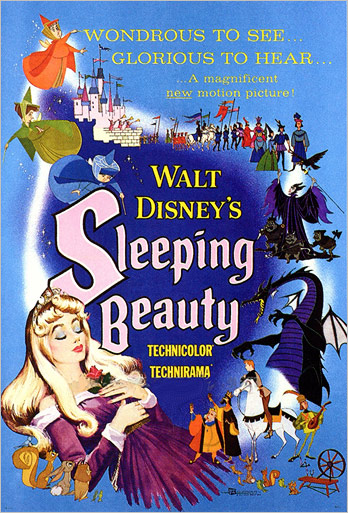 |
||
Walt himself, with proper pride in his organization and staff, spoke of Sleeping Beauty at the time as the ultimate art of animation. In command of wondrous new camera, screen and projection devices here used for the first time in cartoon animation, Walt demonstrated the full power of his own brand of his own brand of artistry to beguile and enchant with the illusionments of life and all its passions. In the medium which he was proven best suited to fairytale and fantasy, he crowded the screen with scenes of poetic beauty, the ecstasies of young love, of protective devotion of good fairies, the fury of the wicked witch and her hench-monsters, and the course of true love. The entire stirring drama of fun and fury leads finally to the deciding violent contest between the champions of good and evil. [Continued below...] |
||
 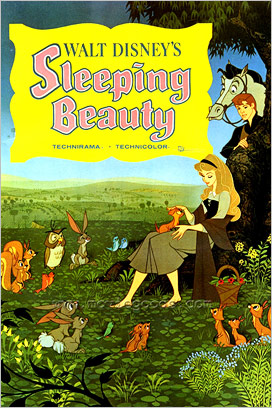
|
||
|
||
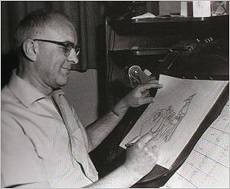 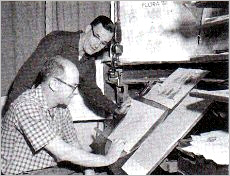 Disney artists at work designing Sleeping Beauty. |
||
The film was directed by Les Clark, Eric Larson, and Wolfgang Reitherman, under the supervision of Clyde Geronimi. Les Clark, born in 1907, was well-known as one of the "Nine Old Men" in the Disney Animation department. Walt originally gained notice of him by spotting lettering he designed for windows in a candy store and complimenting him on his work. Several years later, Clark asked Walt for employment. Clark began work for Disney Studios the day after he graduated high school. Clark's life was changed by Disney's offer. Thankful for the employment and the chance Mr. Disney had taken, he worked extremely hard and continued to thrive with new innovations, not only to do his work as best he could, but to repay Walt for hiring him. He began in the lower-level positions at the studio, but quickly moved up the chain in Disney's favor. His first animation for Disney was actually in a Silly Symphonies, The Skeleton Dance in 1929. He would go on to work on many cartoon shorts until he was able to work on his first feature Snow White and the Seven Dwarfs in 1937 and continue to work on many of Disney's major animated features. Eric Larson was born in Utah in 1905. He entered the University of Utah majoring in journalism and secretly on the side dabbled in animation, his main love. In 1933, he was hired at Disney Studios. Animator Hamilton Luske recognized Larson's talent and promoted him to assistant animator which was followed by his first major job on Snow White. Along with future veteran animators Milt Kahl and James Algar, he animated the forest animals that followed Snow White and would be promoted to work on dozens of major Disney features including Cinderella and Lady and the Tramp.
[Continued below...] |
||
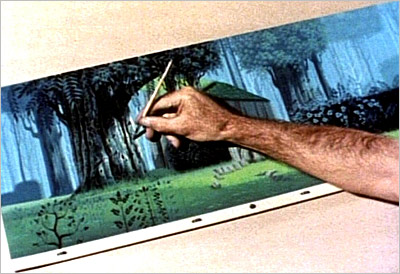 Hand-painting a single frame. |
||
Wolfgang Reitherman was born in 1909 and became another of Disney's "Nine Old Men." Born in Munich, Germany, his family crossed the seas when he was a child and after graduating Pasadena Junior College, became a draftsman for Douglas Aircraft. In 1934, he was hired by Walt Disney where he started working on shorts such as Elmer Elephant and The Band Concert. He would go on to work, as many of the other nine old men, on such films as Pinocchio, Fox and the Hound and 101 Dalmatians. Clyde Geronimi, in charge of many of the animators for Sleeping Beauty, was born in Italy in 1901. He did his first animation for J. R. Bray studios where he worked with Walter Lantz, who later directed the Oswald the Rabbit series for Universal. He left in 1931 to work for Disney where he remained for the rest of his career. He began at Disney in the shorts department and later became a director there. He left Disney in 1959 and worked short-term in television including directing the 1967 animated Spider-Man series. He then retired and spent his time on children's books.
[Continued below...] |
||
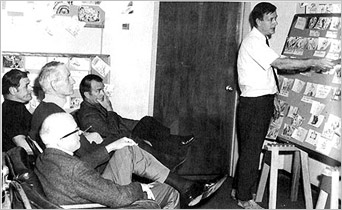 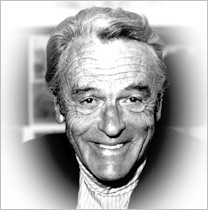 Left: Wolfgang Reitherman demonstrates paintings. Right: Wolfgang in later years. |
||
Walt himself called the perfected animation process used for this film "the art of paintings in life-like motion." Nothing quite comparable to this was achieved at the time in previous fairytales. It set another milestone for Walt. To indicate the colossal scope of the painted drawings for expansion of the beloved old fairytale, it was said at the studio that it would have taken one artist working round the clock 42 years to do the drawings which finally were seen on screen. The animated personage of Princess Aurora was on the story boards and drawing tables for two years in changing guise before she rose free of her creator's pencils. Fully as long in riding free of the drawing boards was the valiant hero, Prince Phillip, whose kiss awakened the Princess from the evil spell after he had slain her in the guise of a monstrous dragon. To achieve realism for these characters, years were spent considering their emotions, look and textures. Color tests were done for a series of months to best stay true to the storybook characters yet bring them alive for the big screen. Walt was on hand, of course, to supervise this entire process and his approval had to be given for every step of the project including the character
development. All of the characters and backgrounds grew slowly out of the imaginations of Walt and over 300 workers until the drawings had come to perfection.
[Continued below...] |
||
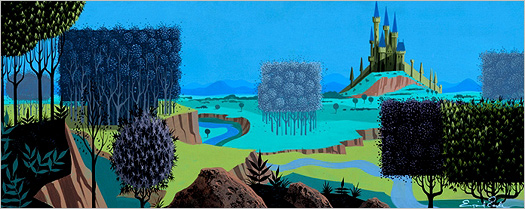 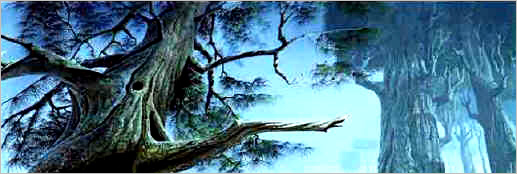 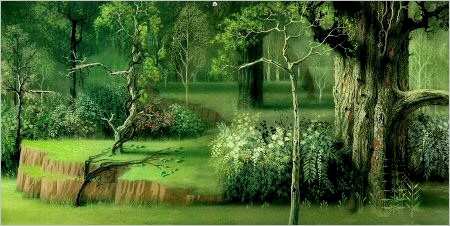 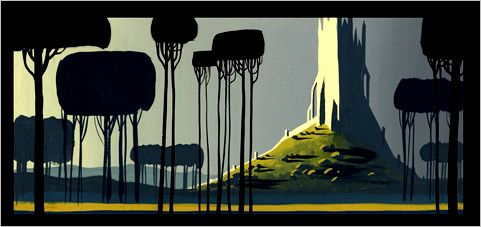 Concept drawings done at the earliest stage of production. |
||
Production began with a reference version, in which the actors were in full costume which was reference for the animators. Of production of the film, Disney was quoted as saying, "The enchanting fable as we saw it for the theater screen posed many formidable new problems. But there were exciting challenges too. The problems involved both the artistry and the mechanics of our biggest undertaking to date. But our artists rose to the occasion. They evolved new styles, new designs, new concepts for the animation of the fairytale. I think they have now developed the process of animation to the point where it truly can be called The Art of Enlivened, Moving Paintings and a way of story telling impossible in any other medium.
[Continued below...] |
||

|
||
This was to be Walt's 70mm Super Technirama 70 Roadshow extravaganza. From the first days of production, every step that was taken to completion was done with the widescreen 70mm process in mind. Work basically doubled for the Disney artists who had to create much wider drawings than they had before. Camera angles and movements changed animation for the film with the widescreen process. Several of the artists were boggled down with work putting in hundreds of extra hours to create the extra work that would compile the new extended images. The advantage of the Technirama screen manifested in the opening scenes of pomp and pageantry when Knights and Ladies join in the procession to the palace to witness the betrothal of the infant Princess Aurora to Prince Phillips. The opening was very important to Walt as the audience was led into the world of fantasy and prepared to engulf the magnificent story. Hollywood specialists were commissioned to supervise and teach the artists and crew members the advantages and process that was widescreen. The work was so difficult and time-consuming that Disney did not use this process again for many years, in fact, only one time since for The Black Cauldron in 1985.
[Continued below...] |
||
 Character profiles created for promotion by the press. |
||
Sound advisers were hired to help perfect the multi-stereo soundtrack that would accompany the film (which, for this video release, is being restored from the original master tapes). Several months of preparation went into recording the soundtrack even before recording had begun. Months were spent recording sound effects, dialogue and music before a mix would come into shape. Having dealt with stereo sound earlier in Fantasia, the sound technicians at Disney had some idea of where to start, but times had changed and so had film processes. Recording Fantasia might be the same as recording Sleeping Beauty, but now the theatrical element had to be taken into consideration as well as the new sound systems. Theater design had changed and so had the way films were recorded and presented to audiences. This would be a learning experience in sound design for the sound engineers at Disney, who would start to use multi-channel recording more with upcoming films like Mary Poppins.
[Continued below...] |
||
 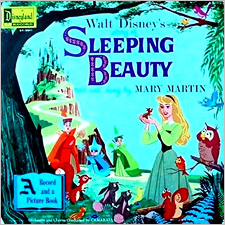  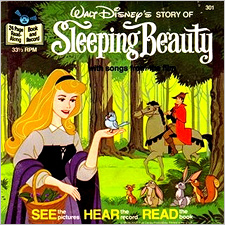 Top Left: Original soundtrack album. Right: Mary Martin LP version. Bottom Left: Reissue soundtrack. Right: Storybook special LP release. |
||
It would be Eyvind Earle who would watch over the style and color of the film, through Walt Disney of course. He started with blacks and went from there, but behind the scenes were many disagreements over the use of color. Eyvind used many sources for the film's style, including Medieval works which contained a flattened look to them. Walt, up to this point, used very soft tones for their backgrounds but this time Eyvind wanted hard and vivid scenery, which ended up being an excellent change. The birds scene in the opening of the film was airbrushed onto 12 foot silk sheets and then were mounted onto rollers and moved past the camera Mark Davis did the original concept color drawings for the witch which was originally black and red, but Eyvind would later change them to black and purple for tone. Born in April of 1916, and by 13 he held his first exhibition in France. By 23, he had sold his first watercolor to the Metropolitan Museum of Art in New York and in the 40's he was painting landscapes for Christmas cards including work for Reader's Digest. Eyvind started work at the Disney studios in 1951. After several years there, he was main stylist for one of Disney's most famous cartoons, Toot Whistle Plunk and Boom. When Sleeping Beauty finished production, he left the studio, it has been said, do to many disagreements over his choices, some of which included sharp edges to characters, which was a change from Disney's soft and round style. He would continue to show work at many famous art exhibitions. He died in July of 2000.
[Continued on Page Two...] |
||
 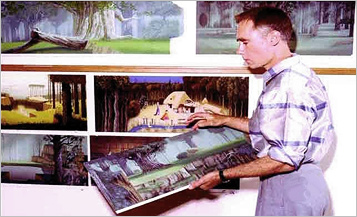 Eyvind Earle hard at work during pre-production. |
On to Page Two...
 |
| Site
designed for 1024 x 768 resolution, using 16M colors and .gif 89a
animation. © 1997-2015 The Digital Bits, Inc., All Rights Reserved. billhunt@thedigitalbits.com |
